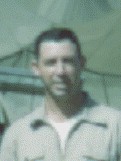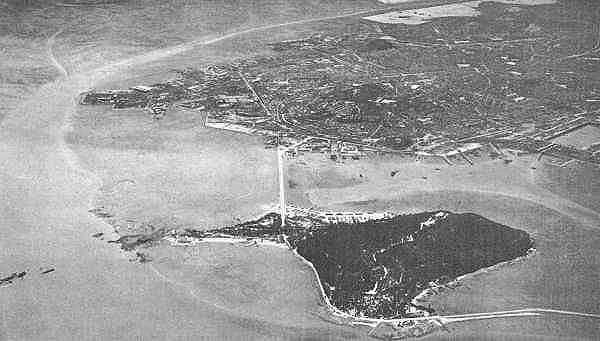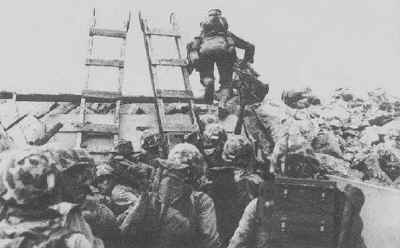THE EARLY YEARS
OF PHOTO JET RECON:
A PERSONAL HISTORY (continued)
by
Colonel Jean K. Woodyard, USAF Retired
Pre-strike and post-strike photos proved or disproved bombing results.
Pre-strike photos frequently required close up oblique approach
photos for fighter-bomber precision attacks.
The RF-80 had in the
nose a photo configuration that normally included a 6" vertical
K22 camera in forward bay — a 12" vertical or oblique
camera mid bay and a 24" vertical K18 in the aft bay which
produced a 9" X 18" photo negative. The other cameras
were 9" X 9" formats.
These camera configurations
gave great flexibility to the pilots’ ability to produce photo
coverage under varying weather and cloud conditions. For example,
to determine the operational status of an airfield target, it could
be covered at 1:10,000 scale from 20,000 feet with a 24" K18
camera, or at 1:10,000 scale at 10,000 feet with a 12" K22
camera, or at 1:10,000 scale at 5,000 feet with a 6" K2 camera.
At lower altitudes, oblique
photos could provide intelligence info, but vertical photos with
60% overlap gave photo interpreters stereo 3 dimensional data.
Clear vertical
photos could be taken at as low as 2,000 feet by slowing the aircraft
to 200-250 mph. An A18 image motion compensation magazine allowed
clear photos at (for example) 200 and 400 mph. The timing controls
were in the cockpit. This was used effectively to determine soil (mud)
status prior to the Inchon amphibious landing by MacArthur’s
forces in September 1950.
Copyright (C) 2000 Jean
K. Woodyard
A PERSONAL HISTORY
(Part II)
by Colonel Jean K. Woodyard,
USAF Retired
Squadron Commander, 8th TRS
In 8th Tactical Reconnaissance
Squadron we took a 24" camera, added a 6" lens (a total
of 36") and then mounted the camera in a forward oblique position
in the RF-80 (looking out the nose of the aircraft). Forward oblique
photos were very useful for fighters attacking targets like the
Suiho reservoir dam and power plant on the North Korean/China border,
which was bombed out. Adding the forward oblique camera required
removal of the radio compass antenna.
Returning on a mission
out of North Korea to K-2 with no radio compass, I let down through
heavy clouds and broke at 1,000’ in rain and fog over a body
of water and as usual low on fuel. If I turned left and was over
the Sea of Japan, I’m down in the water. If I turned right
and was over the Yellow Sea I was going down in China. I guessed
right — found K-2.
A damaged
B-29 from a bombing mission in N. Korea crashed at K-2 in an emergency
landing. A radio maintenance man and I foraged out of the wreckage
a teardrop external radio compass antenna. About a week later it tested
OK mounted under the nose of the RF-80 in which we had the 36"
forward oblique camera. End of that problem.
In MiG alley there were
several key targets — old Sinuiju airfield, a new 6,000 foot
runway under construction to the north, a big multi-span bridge
across the Yalu River and prime supply route from China, several
supply dumps, and the Suiho reservoir with its huge dam and power
plant. Another target — by flying down the Yalu River and
banking the aircraft away from China, the Chinese airfield at Antung
could be photographed obliquely with the vertically mounted 36"
K18 camera [see diagram below]. You could count MiG-15’s on
the airfield. First try the photos were out of focus. On the 2nd
mission, I banked right but pushed the stick forward — the
negative G forces held the film against the camera platen —
very good photos. Since we did not violate Chinese airspace, the
Headquarters "wheels" were delighted and reordered this
target repeatedly along with other targets.
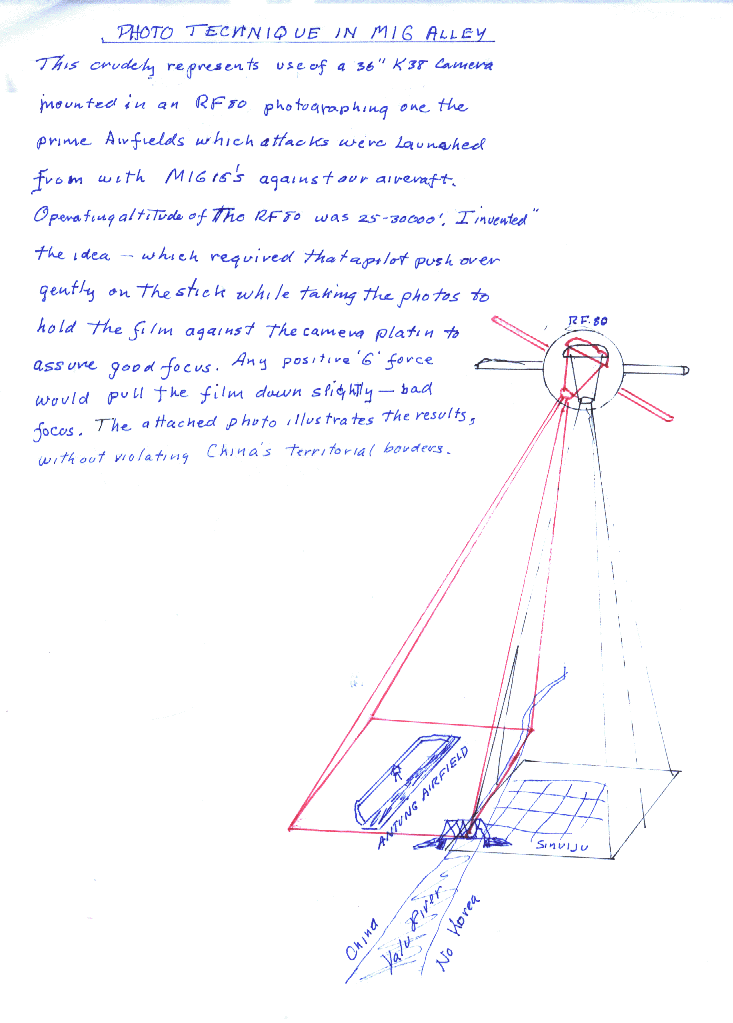
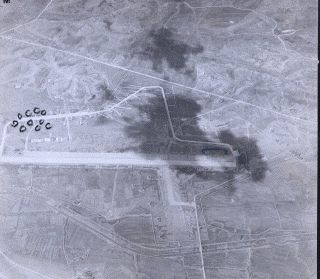
Antung Airfield
Copyright (C) 2000 Jean
K. Woodyard
A PERSONAL HISTORY
(Part III)
by Colonel Jean K. Woodyard,
USAF Retired
Squadron Commander, 8th TRS
RADAR CROSS SECTION OF
RF-80
During the late 1940’s
the radar system called Ground Controlled Approach (GCA) became
operational first at military air bases. Under instrument conditions,
this system brought many aircraft safely down final approach to
safe landing. The F/RF-80 aircraft presented a problem. Radar operators
frequently lost contact and it was determined that this was caused
by the small head-on radar reflective surface — 6.5 sq. feet.
During the Korean War
single RF-80s flew in and out of MiG alley and were rarely intercepted
which suggests low radar reflectivity was an advantage. Ray Schrecengost,
John D. Monaghan and I were the only single guys in the squadron
and we took a major part of the MiG alley missions in 1950-51 because
of the potential hazards. On a VHF radio frequency channel #8 going
into MiG alley you could pick up a harmonic of the sweep on the
Antung airfield radar doing its thing — they were looking!
We were successful in getting one or two escort fighters several
times for MiG alley missions. After two of them got shot up with
AA fire there was no more escort.
Back to
the RF-80 — the small frontal area provided a very low amount
of drag while flying. I was on a photo mission covering several military
cemeteries in Kentucky and Tennessee and was cutting reserve fuel
pretty close when one of the wing tank pump motors failed. Best and
closest airfield was Scott Air Base in Illinois. With remaining usable
fuel I climbed to 18,000 feet and shut down the jet engine with only
ten spare gallons of fuel. I glided about 30 miles to Scott, landed
and cranked the engine up on the ground and barely taxied to the ramp.
At low altitude (below 20,000’) jet aircraft burn fuel very
rapidly compared to higher altitudes.
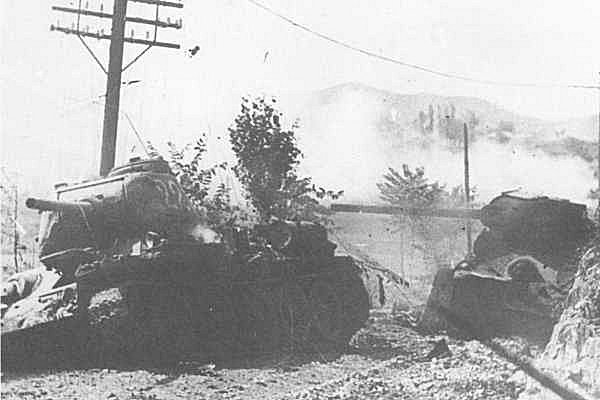
On a visual
recon mission out of Itazuke, Japan, I was sweeping south and west
out of Seoul, Korea, when I spotted three T-34 North Korean tanks.
They had started across a small stream and one bogged down in the
middle. I called 5th Air Force operations for fighters and was promised
them in 20 minutes. After 45 minutes and several calls, I knew that
a landing had to be made at a U.S. operated airfield in South Korea.
I called each of the three airfields available; all reported weather
below landing minimums with low clouds and rain. Fortunately I had
climbed to 35,000 feet and passing Pusan radio beacon on the Korean
coast, I shut down the jet engine with 20 gallons on the fuel gauge.
I glided 90 miles at 220 mph across the Straits of Japan. Periodically,
with the radio compass on battery, I checked my position descending
through 28,000 feet of cloud and broke out over the Itazuke radio
beacon at 3,000 feet just off the end of the runway. The T-34 tanks
got away but the glide ratio on the RF-80 was fully proven. I was
not the only person to do this. Later I talked to Chuck Yeager —
he had done it more than once in a T-33.
EFFORTS TO EXTEND RF-80s
RANGE
Flying
RF-80s out of K-2—Taegu—Korea gave us the capability to
cover most any target in Korea. At FEAF, Far East Air Force Headquarters
in Tokyo efforts were under way to extend our radius of action to
cover targets in China. As we know now, Gen. MacArthur was considering
air attacks on the Chinese mainland should circumstances dictate.
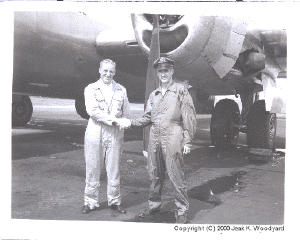
With the first range
extension effort in May of 1951, we mounted two 230 gallon tanks
on the wing tips of two RF-80s and a 130-gallon tank under each
wing. Lt. Ray Schrecengost and I ran tests using rocket assisted
take off at Yakota Air Base in Japan. The center of gravity on the
aircraft was moved aft and takeoffs required guts and above average
pilot skill. Climb, with the extra weight, was slow and operating
at maximum power until external tanks were empty minimized the gain
in range that was expected.
The second range extension
effort in July 1951 involved use of B-29 equipped with a reel-in-reel-out
fuel hose with a funnel-like drogue on the end. It was the forerunner
of the probe and drogue refueling system still in use by the U.S.
Navy and foreign countries. The three RF-80s had probes on the front
of each wing tip 230-gallon fuel tank. As a child if you ever played
"drop the clothes pin in the bottle," you would have a
feel for the problem. The RF-80 pilot had to insert a probe 20 feet
out on his wing tip into 2-foot funnel-like drogue that was dancing
in the wind. Once locked into the drogue, close formation flying
was maintained while the fuel tank began to fill. At about 120 gallons
(720 pounds) the asymmetric load on the heavy wing caused a loss
of positive aileron control. The sequence was: plug in probe on
right wing tank till 1/2 full — break off — plug in
left wing tank probe and receive full fuel — break off and
re-plug in right wing tank for full fuel. This was not only time
consuming but with asymmetric wing loading it took max formation
flying skill and hard work involving several tries at plugging into
the drogue. After practicing a few times, Clyde East, Hank Ezell
and I flew the first "combat air refueling" mission in
Air Force history on 6 July 1951 about 20 miles out from Wonsan
Harbor, North Korea. Radio silence was broken only once on the mission
when Clyde said, "shit" after missing the drogue 3 or
4 times.
Copyright (C) 2000 Jean
K. Woodyard
|





